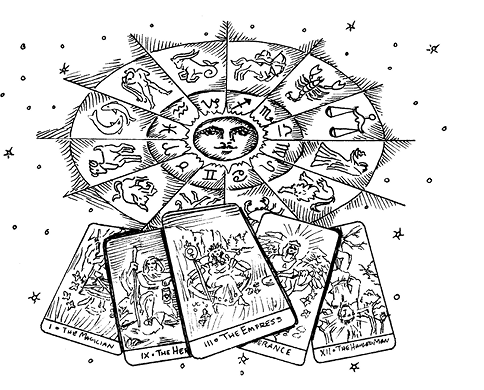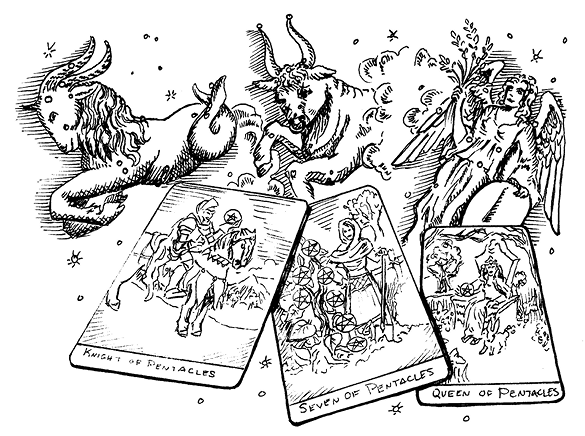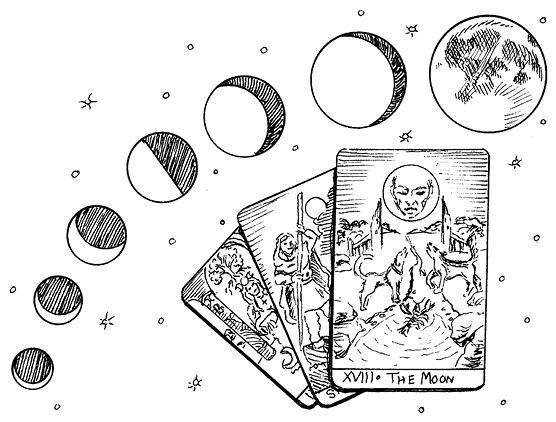The Astrological Elements of Tarot:
Sun Sign Readings for All

When my grandmother gave me a set of tarot cards in the early 1970s, the first thing I did was mislay the instructions. This actually turned out to be a perfectly acceptable strategy for a preteen reader. I loved the Fool card and any of the cards with cats (the Queen of Wands, Strength). But most of them mystified me, and the set soon went into a drawer.
Decades later, I had done some reading on the history of the cards, and it seemed clear that the suits lined up with the astrological elements quite neatly: wands to fire signs (Aries, Leo, and Sagittarius), pentacles to earth signs (Taurus, Virgo, and Capricorn), swords to air signs (Gemini, Libra, and Aquarius), and cups to water signs (Cancer, Scorpio, and Pisces). When you line up the cards in suits (thirteen cards per suit, including a page, knight, queen, and king), you see a narrative unfold. For me as an astrologer, the cards now had extra significance.
When I do tarot workshops here in New England, I often have anywhere from twenty-four to fifty-six attendees, divided into small groups. My instructions always include giving yourself time to study the card. Who is on it—a man, woman, child? What is the person doing? What—or whom—does it “remind” you of? Finally, see how the next card corresponds to the previous ones.
So, if you’re just learning tarot but are overwhelmed by the number of cards, just divide your deck and work with the suit that corresponds to your Sun sign.
Fire Signs and Tarot
Aries, Leo, and Sagittarius have a natural affinity to the wand cards. But you need to slow down your lightning responses long enough to study the images! What are those figures doing with the wands—are they using the wand as a tool, a weapon, a support staff, a flag pole to showcase a triumph? Focus on the expressions of the figures—are they at rest, or are they holding something? Wand cards can have a different interpretation for someone who likes to garden or nurture others. Those little green leaves are so hopeful!
Progress Reading
I’ve found this reading helpful for clients with a lot of fire in their charts, because we just keep on moving on! This utilizes the idea of Celtic cross but dealt to a reader one card at a time:
Card one (center): What is the matter at hand?
Card two (left): What (or who) is getting in the way of forward progress?
Card three (right): What do you have in your arsenal to help you keep moving forward? (Examples: patience, ability to bring other people in, courage to look for other avenues if it’s a job problem)
Since wands are about “doing,” when you are more comfortable, consider adding the cups, which are about feeling. This gives you twenty-six cards to work with, which is plenty!
Earth Signs and Tarot
For Taurus, Virgo, and Capricorn, the signature suit is the pentacle or disk. Many earth sign clients look at a tarot reading as an opportunity to “tune up” or to provide clarity about a situation that seems to be heading towards a crisis. Earth signs are not to be rushed, however. A reading with many low numbers suggests there is time to prepare to take action (very reassuring to earth-sign folks). The pentacles are all pretty merry cards—you won’t see conflict or contentiousness as you do with the wands or swords.

Basic Reading
A sample reading for an earth sign person should definitely include some cards that reflect the past. Try this simple, three-card lineup:
Card one (left): The past. What happened in the past to bring you to this point? (Some earth signs need to really review this information for a while so that they get a handle on their own participation.)
Card two (middle): The present. What are you missing about the current situation? What is on this card that sparks your analytical side?
Card three (right): The future. Pay attention to the number here—a number between one and five suggests that revision or starting over is key; numbers six to ten or the page, knight, queen, or king indicate that resolution will be more straightforward.
Air Signs and Tarot
Gemini, Libra, and Aquarius are the air signs. Swords rule this element, and the sword cards are invariably the most dramatic. Here, you see people slain, in peril, or taking action. Does this mean that taking action (moving through space versus thinking) is the sole domain of air sign folks? Absolutely not, and one quirk of the swords is that many of the cards do not show swordplay, but rather swords at rest, as it were. However, the swords always have an underlying theme about celerity and movement—and we all know many air signs can move faster than a speeding bullet when they need to! Air signs are also highly social, and here’s a sample reading that focuses on air’s unique friend- and ally-making skills.
Crisis Reading
Air signs lead exciting lives and often have to react quickly and decisively. However, one aspect of being an air sign is to be paralyzed by thoughts of indecision. Any signs who sample this reading with just the sword cards may find that images depicting fighting become less fraught for them.
Card one (center): What situation or dilemma has taken center stage?
Card two (beneath): What are the circumstances (which can include people) that are causing stress or strife? What can be done about these impediments (which might also include reluctance to take action or commit to a single path)?
Card three (above): Who are the people and what are the personality characteristics that are strengths or can guide?
Optional card four (to the right of all): The final outcome.
Water Signs and Tarot
For Cancer, Scorpio, and Pisces, working with tarot cards is enormously rewarding. The cups are the suit that represents them, and water sign people invariably have deep intuitive talents—especially if they are able to separate those talents from the anxiety that unexpected insights can bring. Like their element, Cancer, Scorpio, and Pisces are happiest finding their own level and going with the flow. You can translate that to mean they don’t want to be rushed, a trait they share with earth signs. However, some cards indicate stuck-in-the-mud thinking, like the number five, which portrays someone looking sadly at three spilled cups while two upright cups are unseen. Many water signs are rich in relationships, so here is a reading designed for that.
Relationship Reading
Card one (left): What do I bring to and who am I in the relationship?
Card two (right): Who is my partner, and what does this person bring to the relationship?
Card three (below left card): What are the challenges for me in the relationship?
Card four (below right card): What are the challenges for my partner in the relationship?
Card five (above all cards): How will the relationship will unfold?
For all these readings, you will want to pause between laying down cards. To get the most out of tarot—particularly as you are learning the cards—is to see how cards relate to one another one at a time. I’ve seen people lay out spreads with all cards up at once, but that requires a lot more attention than I have!
Practice the reading dependent on your Sun sign. And if you have a friend who is a Sun sign from another element, practice the reading that is appropriate for that element. For example, an Aries can practice the earth sign reading for a Taurus friend, and then the Taurus does a fire sign reading for the Aries.
Lunar Phases and Tarot Cards
Another factor which is both useful and entertaining when you work with your cards is the current lunar phase. When I’ve done large group workshops, I’ve taken advantage of a sweet spot between the first quarter Moon and a few days after the Full Moon. People come into the room ready to listen to something new and ready to talk. More people “get” the connections between cards after working with them briefly. Even those with “Full Moon jitters” are quickly distracted by the images in front of them.

My preference is to do readings by daylight or low light if it’s after dark. Why? Consider how many moving images you view on a screen in a day, on ubiquitous sources from handheld devices to wall-sized televisions. Your brain is the most complex structure in the known universe, according to many researchers, and my personal belief is that it will work better if you look at images that do not move. Studying one tarot card—focusing on the person or people, the colors, the action suggested, the meaning you interpret—is an exciting prospect for your subconscious. I always ask clients, “What do you see?” more than once if a card isn’t obvious. Cards like Temperance and Strength are wonderfully clear, but they are outnumbered by more subtle images!
More Complex Readings
Once you are comfortable with the suit that works for your astrological element, consider adding the other suits. I have done many readings without major arcana to see the connections between the suits themselves. However, adding the major arcana is where you really can have fun with a reading. Now you are adding cards that are easier to interpret. (Can we all agree that the terrifying-looking Death card usually means “decisive transition” instead of the Grim Reaper?)
Say you have a spread that is heavy on cups, and then VIII, the Strength card (the lady with the lion), turns up. That card definitely indicates that taking the deep breath and preparing for the adrenaline that comes with emotional disturbance is in order. Or the spread might have lots of pentacles and wands, indicating a work situation is in play. And then the Tower (XVI), which represents the Tower of Babel tumbling and which immediately follows the Devil, shows up. One interpretation may be that finances at the place you work are strained, and one possibility is that the company or organization may change ownership—or that if a change is underway, it’s reaching a crescendo.
However, an astrological interpretation of the above two examples also suggests that major players (which can include the querent) could be born under a sign that is in that element (cups being water signs, etc.).
Yearlong Reading
Here is a fun reading for January. You can also do it for any month, as it’s a long-range reading. Record the cards, and see how they unfold. (I prefer to do this reading without major arcana.)
Lay out twelve cards in the shape of a horoscope (or a clock face), starting with a card in the position that “nine o’clock” would be in (this corresponds to the Ascendent or rising sign). Lay out card in nine o’clock, eight o’clock, seven o’clock, etc., all the way to ten o’clock, the last card.
If you are reading in December or the start of the new year, the card in the nine o’clock position represents January. The card in the eight o’clock position represents February. Look at the cards slowly, and see whether the “theme” for wands, pentacles, swords, and cups (fire, earth, air, and water) carries through for that month.
For example, January turns up the two of swords. Swords represent air signs, so there may be folks born under Gemini, Libra, and Aquarius who play a major role in your life that month. The theme would be “intellectual activity,” “taking action,” etc. You can also do this reading at the start of each month—give yourself a card as that month’s theme!
Finally, one of the pleasures of tarot cards is a seemingly infinite array of readings as well as the range of interpretive possibilities. Start slow and move on to more complicated readings, and you will find that your self-knowledge, as well as intuition, increases.